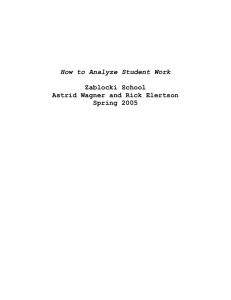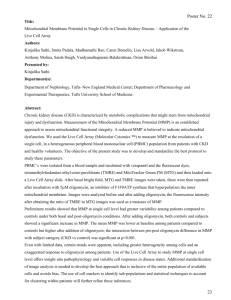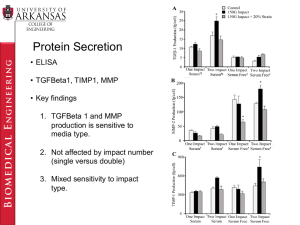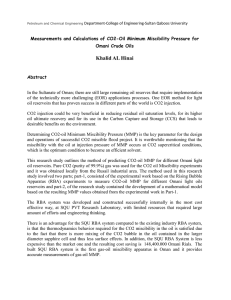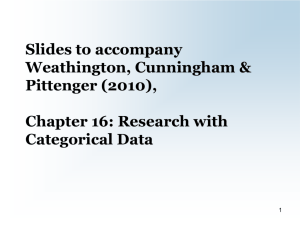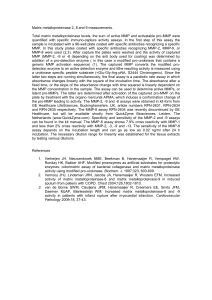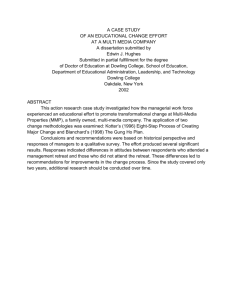Research Journal of Applied Sciences, Engineering and Technology 7(15): 3159-3163,... ISSN: 2040-7459; e-ISSN: 2040-7467
advertisement
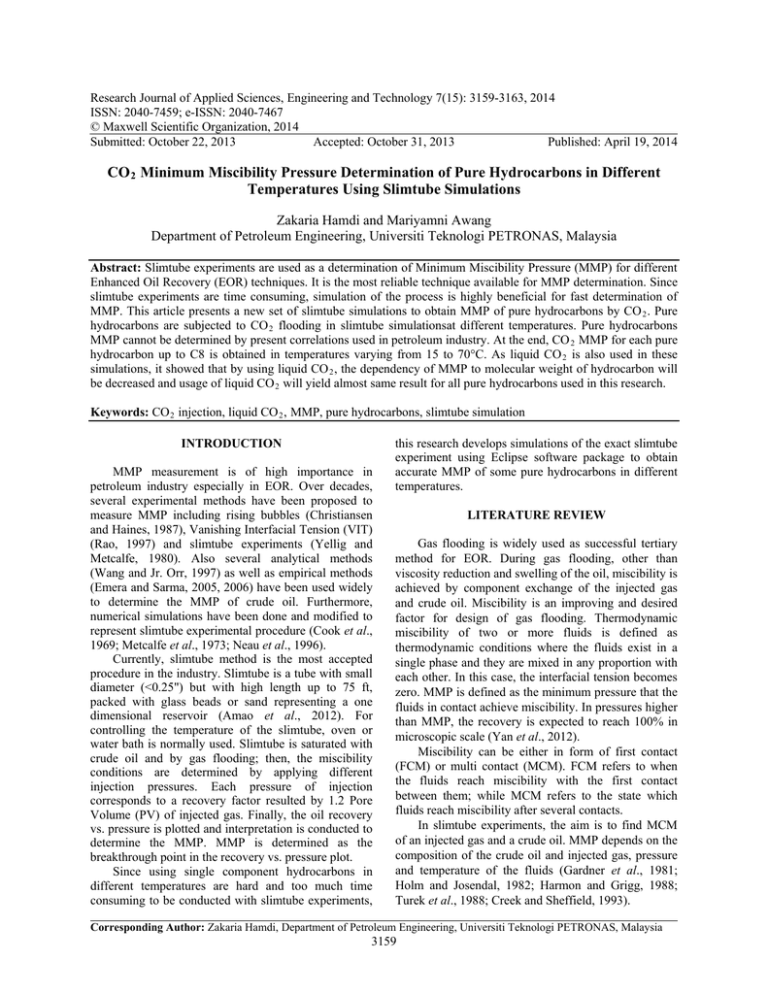
Research Journal of Applied Sciences, Engineering and Technology 7(15): 3159-3163, 2014 ISSN: 2040-7459; e-ISSN: 2040-7467 © Maxwell Scientific Organization, 2014 Submitted: October 22, 2013 Accepted: October 31, 2013 Published: April 19, 2014 CO 2 Minimum Miscibility Pressure Determination of Pure Hydrocarbons in Different Temperatures Using Slimtube Simulations Zakaria Hamdi and Mariyamni Awang Department of Petroleum Engineering, Universiti Teknologi PETRONAS, Malaysia Abstract: Slimtube experiments are used as a determination of Minimum Miscibility Pressure (MMP) for different Enhanced Oil Recovery (EOR) techniques. It is the most reliable technique available for MMP determination. Since slimtube experiments are time consuming, simulation of the process is highly beneficial for fast determination of MMP. This article presents a new set of slimtube simulations to obtain MMP of pure hydrocarbons by CO 2 . Pure hydrocarbons are subjected to CO 2 flooding in slimtube simulationsat different temperatures. Pure hydrocarbons MMP cannot be determined by present correlations used in petroleum industry. At the end, CO 2 MMP for each pure hydrocarbon up to C8 is obtained in temperatures varying from 15 to 70°C. As liquid CO 2 is also used in these simulations, it showed that by using liquid CO 2 , the dependency of MMP to molecular weight of hydrocarbon will be decreased and usage of liquid CO 2 will yield almost same result for all pure hydrocarbons used in this research. Keywords: CO 2 injection, liquid CO 2 , MMP, pure hydrocarbons, slimtube simulation INTRODUCTION MMP measurement is of high importance in petroleum industry especially in EOR. Over decades, several experimental methods have been proposed to measure MMP including rising bubbles (Christiansen and Haines, 1987), Vanishing Interfacial Tension (VIT) (Rao, 1997) and slimtube experiments (Yellig and Metcalfe, 1980). Also several analytical methods (Wang and Jr. Orr, 1997) as well as empirical methods (Emera and Sarma, 2005, 2006) have been used widely to determine the MMP of crude oil. Furthermore, numerical simulations have been done and modified to represent slimtube experimental procedure (Cook et al., 1969; Metcalfe et al., 1973; Neau et al., 1996). Currently, slimtube method is the most accepted procedure in the industry. Slimtube is a tube with small diameter (<0.25") but with high length up to 75 ft, packed with glass beads or sand representing a one dimensional reservoir (Amao et al., 2012). For controlling the temperature of the slimtube, oven or water bath is normally used. Slimtube is saturated with crude oil and by gas flooding; then, the miscibility conditions are determined by applying different injection pressures. Each pressure of injection corresponds to a recovery factor resulted by 1.2 Pore Volume (PV) of injected gas. Finally, the oil recovery vs. pressure is plotted and interpretation is conducted to determine the MMP. MMP is determined as the breakthrough point in the recovery vs. pressure plot. Since using single component hydrocarbons in different temperatures are hard and too much time consuming to be conducted with slimtube experiments, this research develops simulations of the exact slimtube experiment using Eclipse software package to obtain accurate MMP of some pure hydrocarbons in different temperatures. LITERATURE REVIEW Gas flooding is widely used as successful tertiary method for EOR. During gas flooding, other than viscosity reduction and swelling of the oil, miscibility is achieved by component exchange of the injected gas and crude oil. Miscibility is an improving and desired factor for design of gas flooding. Thermodynamic miscibility of two or more fluids is defined as thermodynamic conditions where the fluids exist in a single phase and they are mixed in any proportion with each other. In this case, the interfacial tension becomes zero. MMP is defined as the minimum pressure that the fluids in contact achieve miscibility. In pressures higher than MMP, the recovery is expected to reach 100% in microscopic scale (Yan et al., 2012). Miscibility can be either in form of first contact (FCM) or multi contact (MCM). FCM refers to when the fluids reach miscibility with the first contact between them; while MCM refers to the state which fluids reach miscibility after several contacts. In slimtube experiments, the aim is to find MCM of an injected gas and a crude oil. MMP depends on the composition of the crude oil and injected gas, pressure and temperature of the fluids (Gardner et al., 1981; Holm and Josendal, 1982; Harmon and Grigg, 1988; Turek et al., 1988; Creek and Sheffield, 1993). Corresponding Author: Zakaria Hamdi, Department of Petroleum Engineering, Universiti Teknologi PETRONAS, Malaysia 3159 Res. J. Appl. Sci. Eng. Technol., 7(15): 3159-3163, 2014 temperature may be formed in different parts of the reservoir (Hamdi and Awang, 2013). This will cause different MMP values in crude oil inside a reservoir. Therefore, several temperatures are taken into account to evaluate the effect of temperatures on MMP of different hydrocarbons. Previous correlations of MMP were not obtained based on single hydrocarbons and usually C5+ or C7+ is taken as the main component for determination of MMP and C1-C4 were not considered individually (Holm and Josendal, 1974; Cronquist, 1978; Yellig and Metcalfe, 1980; Alston et al.,1985). This study will determine each hydrocarbon MMP in different temperatures so that the MMP of crude oil or mixed hydrocarbons may be investigated based on each pure hydrocarbons. 100 80 60 40 20 Pressures (MPa) Liquid 9 7 5 3 Critical point Solid Vapor 1.0 0.8 0.6 0.4 Triple point 0.2 0.1 -100 -50 0 150 50 100 Temperature (°C) 200 150 Fig. 1: CO 2 phase diagram (Baviere, 1980) Table 1: Dunyushkin and Namiot (1978) available MMP correlations Temperature (°C) --------------------------------------------------------------Component 30 50 70 C7 72 94 112 C8 72 97 119 Table 2: Glass MMP correlations Temperature (°C) --------------------------------------------------------------Component 15.000 30.000 50.000 70.000 C7 258.67 295.87 345.48 395.08 C8 234.90 262.71 299.79 336.87 CO 2 flooding is used in EOR as well as sequestration. CO 2 flooding can be in form of liquid or gas depending on pressure of injection and temperature as shown in Fig. 1. Generally, CO 2 floods have been used for reservoirs with pressures above MMP (Stalkup Jr., 1983; Hadlow, 1992). So determination of MMP can determine the aspect of CO 2 usage for EOR. Temperature is assumed to be constant in slimtube experiments. However this assumption is not true as previous studies showed that if injected gas and reservoir has different temperatures, a local equilibrium Previous correlations: The equations and correlations used so far cannot cover the range used in this study. Holm and Josendal (1974) MMP correlation from CO 2 flooding used C5+ with minimum molecular weight of 180 that is not in the range of study. Mungan (1981) is later extended their work by increasing the upper limit of molecular weight to 340, while leaving molecular weight less than 180 with no correlation. Dunyushkin and Namiot (1978) presented a graph for MMP correlation which covered only a part of the study presented in Table 1. Cronquist (1978) correlation for CO 2 MMP was based on C5+. Glass correlation for CO 2 MMP was based on C2-6 and C7+ composition in total which leads to uncertain values for pure hydrocarbons (Glass, 1985). The results of hydrocarbons that can be obtained with Glass correlation is presented in Table 2. As we can compare with Dunyushkin correlation, there is a large gap between the values. Our simulations suggest that Glass correlation is not suitable for pure hydrocarbons. Furthermore, Yuan’s CO 2 MMP correlation is not usable as no pure hydrocarbon can be fit into the correlation (Yuan et al., 2005). Since no correlation can validate the work, a C7+ component is tested in our simulations in order to validate our methodology and to check if slimtube results are acceptable. MMP of C7+ is calculated using previous correlations and the results presented in Table 3. Table 3: C7+ MMP determination by different correlations Temperature (°C) -----------------------------------------------------------------15.0 30.000 50.000 70.000 MMP Correlations Dunyashkin (Dunyushkin and Namiot, 1978) 165.00 200.00 Holm (Holm and Josendal, 1974) 95.000 123.13 164.63 Cronquist (1978) 60.3 87.420 123.36 159.14 Glass (1985) 200 223.68 254.51 3160 286.33 Remarks Assumed that C1 and N2 is present that increase the calculated MMP It is assumed that C2-4 is present that can cause up to 150 atm reduction Res. J. Appl. Sci. Eng. Technol., 7(15): 3159-3163, 2014 Table 4: Initial data used in simulation Parameter Slimtube length-m Slimtube cross section-cm Solution method Equation of State (EOS) Grid dimensions Porosity (%) Permeability-D Compressibility of rock (1/atm) Initial hydrocarbon saturation (%) Gas saturation (%) Initial hydrocarbon saturation (%) Total pore volume (mL) Injection rate-PV per hour Duration of injection (h) Capillary pressure (atm) METHODOLOGY Amount 10 1 Fully implicit Peng-robinson 200×1×1 10 2 0.000004 at 136 atm 100 S gas = 1-S oil 100 100 0.1 12 0 Table 5: Properties of CO 2 and hydrocarbons used in the simulations Molecular Critical Critical pressure Name weight temperature (°C) (atm) CO 2 44.0100 31.55000 72.90000 C1 16.0430 -82.5500 45.44000 C2 30.0700 32.28000 48.20000 C3 44.0970 96.65000 42.10000 iC4 58.1240 134.9500 36.00000 nC4 58.1240 152.0500 37.47000 iC5 72.1510 187.2500 32.90000 nC5 72.1510 196.4500 33.31000 C6 84.0000 238.8500 32.96000 nC7 100.210 275.5037 31.48673 nC8 114.231 307.5218 29.15231 C7+ 218.000 471.7747 16.84718 Relative permeability 1.0 Oil Gas 0.8 0.6 0.4 0.2 0 0 0.2 0.4 0.6 Oil saturation 0.8 Fig. 2: Relative permeability curves vs. oil saturation Total mole production 1.2 1.0 0.8 MMP 0.6 0.4 0.2 0 0 100 300 400 200 Operation pressure (atm) Fig. 3: Example of slimtube simulation result To obtain the PVT properties of different hydrocarbons, PVTi software is used. Based on available Equation of State (EOS) parameters for each pure hydrocarbon, critical temperature, specific gravity, acentric factor and other data can be made to use in the slimtube model. Then, the PVT data is added to the main simulator for the slimtube experiment, i.e., Eclipse 300 as the simulation software package. Different temperatures are used to perform these simulations. 15, 30, 50 and 70°C are chosen to perform the experiments. In 15 and 30°C, CO 2 is liquid according to its phase behavior. For each temperature, the simulations are performed with pressures 30 to 90 atm with a 5 atm interval and then from 100 to 600 atm with 100 atm interval. The initial data used for the simulations are presented in Table 4. Different pure hydrocarbons are used to perform slimtube simulations. Also, a C7+ sample is added to the simulation, representing heavy component.The properties of CO 2 and the hydrocarbon used in this simulation are shown in Table 5. Also, the relative permeability curves used in slimtube simulation is shown in Fig. 2. Because in different temperatures different hydrocarbons may be gas or liquid, choosing total oil recovery may lead to wrong interpretation of MMP. Therefore, instead of recovery factor, the total mole of each hydrocarbon produced is taken into the consideration. Based on each component and for each temperature, a simulation is performed. Then, the total mole of hydrocarbon produced vs. pressures is plotted for respective component and temperature. The breakthrough point is then determined and considered as MMP of specific hydrocarbon at the indicated temperature (Fig. 3). 1.0 RESULTS AND DISCUSSION Because 44 plots are not possible to be presented in this study, only the calculated MMP is presented as in Table 6. Since the previous correlations and methods were not built on the basis that the crude oil can be pure hydrocarbon, any comparison was not possible. But the validation is made through the comparison of previous correlation with the C7+ component. A sample plot is shown in Fig. 3 to present the trend of hydrocarbon production in different operating pressures. Also the MMP is plotted based on extrapolation of lines connecting the results. The results seem to be valid for all the hydrocarbons except C1. There is no breakthrough of 500 the plot in any of operating temperatures. In Fig. 4 the slimtube simulations for C1 in 50°C is shown. As it can be realized, MMP cannot be determined. The reason is 3161 Res. J. Appl. Sci. Eng. Technol., 7(15): 3159-3163, 2014 Table 6: MMP values calculated for different temperatures (atm) Temperature (°C) --------------------------------------------------------------Component 15 30 50 70 C1 (not valid) 346.6001 352.8258 381.8939 393.875600 C2 56.26267 71.82837 98.83110 143.243425 C3 51.91211 71.29087 75.59448 76.3606200 iC4 50.92321 69.92521 74.94124 78.8150000 nC4 50.65779 72.26347 76.61120 86.3303100 iC5 50.52278 71.78257 83.05838 89.6197800 nC5 50.44509 72.31052 82.15326 93.7615700 C6 50.31336 75.46238 85.90020 110.320000 nC7 50.15092 75.34349 98.25993 125.503400 nC8 50.14613 80.43694 112.2868 138.937700 C7+ 50.34290 84.21965 155.2369 213.973500 Total mole production 2.5 2.0 1.5 1.0 0.5 0 0 100 200 300 400 500 600 700 800 900 1000 Operation pressure (atm) Fig. 4: Methane slimtube simulation results in T = 50 °C 250 MMP (atm) 200 150 100 50 15 C 30 C 50 C 70 C that because of very low molecular weight of C1, injection of CO 2 will not cause single phase system and therefore, C1 has to be injected into CO 2 in order to achieve miscibility. Figure 5 and 6 represent the MMP calculated from slimtube simulations. In Fig. 5, we can see that in high temperatures, other than C2, by increasing the molecular weight MMP is also increasing steadily. But in low temperatures, MMP does not change significantly. This suggests that when CO 2 is liquid, MMP of pure hydrocarbons remain low and independent from molecular weight of the hydrocarbon. In Fig. 6, MMP is plotted vs. temperature of slimtube for each pure hydrocarbon. Increase in MMP by increase in temperature is as expected. The figure also shows that when CO 2 is liquid, MMP is decreased steadily but with slower rate. The reason is that according to Miller, solubility of CO 2 into hydrocarbons reaches almost a constant amount and cannot cause earlier miscibility between CO 2 and hydrocarbon (Miller and Jones, 1981). As the temperature increases, dependency of solubility to temperature is also increasing, causing higher rate of MMP increase. By comparing iC4 and iC5 with nC4 and nC5, respectively, it is realized that in temperatures 50°C and below, same molecular weight will cause almost same MMP value. This suggests that by knowing molecular weight of a hydrocarbon, miscibility can be determined without knowing actual component of hydrocarbon. The MMP values of C7+ are compared with previous correlation results. Cronquist correlation seems to be the nearest match to our results that can be interpreted as successful simulation of C7+ as well as other pure hydrocarbons. CONCLUSION In this research several slimtube simulations were done with pure hydrocarbon using CO 2 as injection gas. C2 C3 iC4 NC4 iC5 nC5 C6 nC7 nC8 C7+ The MMP of each hydrocarbon is determined and Hydrocarbons presented based on slimtube simulation in different temperatures. Fig. 5: MMP of pure hydrocarbons in different temperature For temperatures below 50°C, MMP of each hydrocarbon can be reflected on its molecular weight 250 C2 and not its nature. It means that each molecular weight C3 can produce one MMP that can be used for other IC4 200 NC4 hydrocarbons with same molecular weight. IC5 150 Liquid CO 2 MMP simulation results are published NC5 for the first time and the results suggest that using C6 100 liquid CO 2 will cause the MMP to be independent from NC7 molecular weight. MMP will still decrease by NC8 50 decreasing temperature and the reduction rate is C7+ constant for all components used in this research. This 0 opens a new look for usage of liquid CO 2 in different 40 30 0 20 50 60 70 80 10 tertiary recovery methods. Temperature ( °C) This research opens an opportunity for further studies to analyze and determine the miscibility of Fig. 6: MMP vs. temperature of slimtube for each pure hydrocarbon crude oil based on each hydrocarbon component. 3162 MMP (atm) 0 Res. J. Appl. Sci. Eng. Technol., 7(15): 3159-3163, 2014 ACKNOWLEDGMENT Authors would like to thank Universiti Teknologi PETRONAS for its assistantship support and software licensing of Eclipse 300. Also the author would thanks Babak Moradi for his assistance. REFERENCES Alston, R.B., G.P. Kokolis and C.F. James, 1985. CO2 minimum miscibility pressure: A correlation for impure CO2 streams and live oil systems. Soc. Petrol. Eng. J., 25(2): 268-274. Amao, A.M., S. Siddiqui and H. Menouar, 2012. A new look at the Minimum Miscibility Pressure (MMP) determination from slimtube measurements. Proceeding of the SPE Improved Oil Recovery Symposium. Society of Petroleum Engineers, Tulsa, Oklahoma, USA. Baviere, M., 1980. Basic Concepts in Enhanced Oil Recovery Processes. Elsevier Applied Science, London, New York. Christiansen, R.L. and H.K. Haines, 1987. Rapid measurement of minimum miscibility pressure with the rising-bubble apparatus. SPE Reservoir Eng., 2(4): 523-527. Cook, A.B., C.J. Walker and G.B. Spencer, 1969. Realistic K values of C7+ hydrocarbons for calculating oil vaporization during gas cycling at high pressures. J. Petrol. Technol., 21(7): 901-915. Creek, J.L. and J.M. Sheffield, 1993. Phase behavior, fluid properties and displacement characteristics of permian basin reservoir fluid/CO2 systems. SPE Reservoir Eng., 8(1): 34-42. Cronquist, C., 1978. Carbon dioxide dynamic miscibility with light reservoir oils. Proceeding of the US DOE Annual Symposium. Dunyushkin, I.I. and A.Y. Namiot, 1978. Mixing conditions of oil with carbon dioxide. Neft. Khozyaistov, pp: 59-61. Emera, M.K. and H.K. Sarma, 2005. Use of genetic algorithm to predict Minimum Miscibility Pressure (MMP) between flue gases and oil in design of flue gas injection project. Proceeding of the SPE Middle East Oil and Gas Show and Conference. Society of Petroleum Engineers, Kingdom of Bahrain. Emera, M.K. and H.K. Sarma, 2006. A reliable correlation to predict the change in minimum miscibility pressure when CO2 is diluted with other gases. SPE Reserv. Eval. Eng., 9(4): 366-373. Gardner, J.W., F.M. Orr and P.D. Patel, 1981. The effect of phase behavior on CO2-flood displacement efficiency. SPE J. Petrol. Technol., 33(11): 2067-2081. Glass, O., 1985. Generalized minimum miscibility pressure correlation (includes associated papers 15845 and 16287). Soc. Petrol. Eng. J., 25(6): 927-934. Hadlow, R.E., 1992. Update of industry experience with CO2 injection. Proceeding of the SPE Annual Technical Conference and Exhibition. Society of Petroleum Engineers Inc., Washington, D.C. Hamdi, Z. and M. Awang, 2013. Improving oil recovery by cold CO2 injection: A simulation study. Int. J. Petrol. Geosci. Eng., 1(3): 167-177. Harmon, R.A. and R.B. Grigg, 1988. Vapor-density measurement for estimating minimum miscibility pressure (includes associated papers 19118 and 19500). SPE Reservoir Eng., 3(4): 1215-1220. Holm, L.W. and V.A. Josendal, 1974. Mechanisms of oil displacement by carbon dioxide. SPE J. Petrol. Technol., 26(12): 1427-1438. Holm, L.W. and V.A. Josendal, 1982. Effect of oil composition on miscible-type displacement by carbon dioxide. Soc. Petrol. Eng. J., 22(1): 87-98. Metcalfe, R.S., D.D. Fussell and J.L. Shelton, 1973. A multicell equilibrium separation model for the study of multiple contact miscibility in rich-gas drives. Soc. Petrol. Eng. J., 13(3): 147-155. Miller, J.S. and R.A. Jones, 1981. A laboratory study to determine physical characteristics of heavy oil after CO2 saturation. Proceeding of the SPE/DOE Enhanced Oil Recovery Symposium. Tulsa, Oklahoma. Mungan, N., 1981. Carbon dioxide floodingfundamentals. J. Can. Petrol. Technol., 20(1). Neau, E., L. Avaullée and J.N. Jaubert, 1996. A new algorithm for enhanced oil recovery calculations. Fluid Phase Equilibr., 117(1-2): 265-272. Rao, D.N., 1997. A new technique of vanishing interfacial tension for miscibility determination. Fluid Phase Equilibr., 139(1-2): 311-324. Stalkup Jr., F.I., 1983. Miscible Displacement. In: Henry, L. (Ed.), Doherty Memorial Fund of AIME, Society of Petroleum Engineers of AIME, New York, Dallas. Turek, E.A., R.S. Metcalfe and R.E. Fishback, 1988. Phase behavior of several CO2/ west texasreservoir-oil systems. SPE Reservoir Eng., 3(2): 505-516. Wang, Y. and F.M. Jr. Orr, 1997. Analytical calculation of minimum miscibility pressure. Fluid Phase Equilibr., 139(1-2): 101-124. Yan, W., M.L. Michelsen and E.H. Stenby, 2012. Calculation of minimum miscibility pressure using fast slimtube simulation. Proceeding of the SPE Improved Oil Recovery Symposium. Society of Petroleum Engineers, Tulsa, Oklahoma, USA. Yellig, W.F. and R.S. Metcalfe, 1980. Determination and prediction of CO2 minimum miscibility pressures (includes associated paper 8876). SPE J. Petrol. Technol., 32(1): 160-168. Yuan, H., R.T. Johns, A.M. Egwuenu and B. Dindoruk, 2005. Improved MMP correlations for CO2 floods using analytical gasflooding theory. SPE Reserv. Eval. Eng., 8(5): 418-425. 3163
